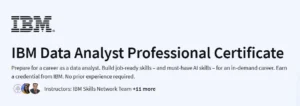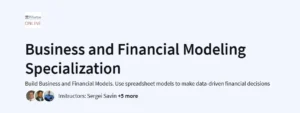What will you learn in Time Series Analysis with Python Course
Grasp fundamental time series concepts such as stationarity, seasonality, and trend.
Manipulate and preprocess time-indexed data with Pandas and NumPy.
Visualize temporal patterns with Matplotlib, Seaborn, and specialized TS plots.
Decompose series into trend, seasonal, and residual components.
Build and tune forecasting models: ARIMA, SARIMA, exponential smoothing, and Prophet.
Program Overview
Module 1: Introduction to Time Series Analysis
⏳ 1 hour
Topics: Time series definitions, components, and common use cases.
Hands-on: Load sample datasets and plot basic time series charts.
Module 2: Data Manipulation & Preprocessing
⏳ 1.5 hours
Topics: Date/time indexing, resampling, rolling/window functions, handling missing timestamps.
Hands-on: Clean and resample real-world time series data using Pandas.
Module 3: Visualization & Exploratory Analysis
⏳ 1 hour
Topics: Line plots, autocorrelation (ACF), partial autocorrelation (PACF), seasonal plots.
Hands-on: Generate ACF/PACF charts and seasonal subplots to detect patterns.
Module 4: Decomposition & Stationarity Testing
⏳ 1.5 hours
Topics: Additive vs. multiplicative decomposition, Dickey–Fuller test, detrending techniques.
Hands-on: Decompose a series and apply stationarity tests; transform data for modeling.
Module 5: Classical Forecasting Models (ARIMA/SARIMA)
⏳ 1.5 hours
Topics: AR, MA, ARMA, ARIMA, SARIMA concepts, identifying p/d/q hyperparameters.
Hands-on: Fit and forecast ARIMA/SARIMA models; use grid search for order selection.
Module 6: Exponential Smoothing & Prophet
⏳ 1 hour
Topics: Simple, Holt’s, and Holt–Winters exponential smoothing; Facebook Prophet basics.
Hands-on: Build and compare ETS and Prophet forecasts on seasonal data.
Module 7: Model Evaluation & Tuning
⏳ 1 hour
Topics: Train/test splits for time series, walk-forward validation, error metrics.
Hands-on: Implement backtesting loops and compute MAE, RMSE, and MAPE for model comparison.
Module 8: Advanced Topics & Deployment
⏳ 1 hour
Topics: Multivariate forecasting (VAR), intro to LSTM for time series, scheduling forecasts with cron or Airflow.
Hands-on: Prototype a VAR model and containerize a forecasting script for scheduled runs.
Get certificate
Job Outlook
Time series expertise is highly valued in finance, supply chain, energy, and IoT analytics.
Roles include Forecast Analyst, Quantitative Analyst, Data Scientist, and MLOps Engineer focusing on temporal data.
Salaries range from $80K–$130K USD depending on industry and experience level.
Mastery of forecasting and deployment practices opens opportunities in algorithmic trading, demand planning, and predictive maintenance.
Specification: Time Series Analysis with Python Course
|
FAQs
- Basic Python and Pandas familiarity is recommended.
- No advanced coding experience is required.
- Hands-on exercises teach time-indexed data manipulation and visualization.
- Emphasis is on practical forecasting and deployment tasks.
- Beginners may need extra practice on Python data structures for smooth learning.
- Yes, it covers ARIMA, SARIMA, exponential smoothing, and Prophet.
- Labs include preprocessing, model tuning, and error evaluation.
- Multivariate forecasting (VAR) and introductory LSTM are also included.
- Provides experience in model backtesting and walk-forward validation.
- Prepares learners for finance, supply chain, energy, and IoT analytics projects.
- Finance: stock prediction and algorithmic trading.
- Supply chain: demand planning and inventory optimization.
- Energy: load forecasting and predictive maintenance.
- IoT and sensor analytics for real-time monitoring.
- Roles include Forecast Analyst, Quantitative Analyst, and Data Scientist.
- Focused on temporal data analysis rather than general programming.
- Covers decomposition, stationarity testing, and advanced forecasting methods.
- Emphasizes end-to-end pipeline: preprocessing → modeling → evaluation → deployment.
- Hands-on labs simulate real-world forecasting scenarios.
- Unlike general Python tutorials, it targets practical business and scientific applications.
- Yes, the course covers scheduling forecasts using cron or Airflow.
- Guides on containerizing scripts for automated execution.
- Includes evaluation and monitoring of model performance.
- Focuses on small to medium-scale deployment; large-scale cloud deployment may require additional learning.
- Prepares learners for end-to-end forecasting solutions in industry projects.





